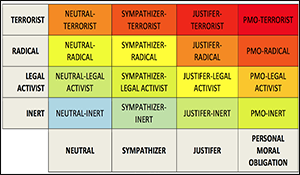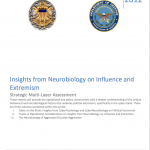Neurobiology Insights on Influence and Extremism

Insights from Neurobiology on Influence and Extremism.
Author | Editor: Orlina, E. & Desjardins, A. (NSI, Inc).
These reports will provide the operational and policy communities with a deeper understanding of the unique behavioral and neurobiological factors that underlie political extremism, specifically in the cyber realm. There are three volumes contained within this series:
- Cyber on the Brain: Insights from CyberPsychology and CyberNeurobiology on Political Extremism
- Topics in Operational Considerations on Insights from Neurobiology on Influence and Extremism
- The Neurobiology of Aggression/Counter-Aggression
This white paper provides a unique and multi-disciplinary perspective on political extremism in the cyberspace realm by assessing the processes by which political extremism is affected by advances in communication technology and the online environment. Advances in the Internet and related technologies have played, and continue to play, an important role in all aspects of national security. The convergence of technology and social media has presented great opportunities, but also generates security risks. It is suggested that cyber-based communications technology helps foster connections among groups of individuals, allowing for the spread of memes and movements for peaceful change. Yet, at the same time, the Internet and related technologies may enhance the emergence of violent extremist organizations as well as subsequent recruitment. This is an exploratory first step towards understanding the implications for cyber-based communications technology on the root factors pertaining to political extremism.
Advances in the Internet and related technologies have played, and continue to play, an important role in all aspects of national security. The convergence of technology and social media has generated opportunities for improved target audience communications and interventions, but also provides individuals who may seek to harm with the ability to communicate their own messages and ideologies around the world quickly and broadly. These opportunities, and the development and continued advances in cyber technologies including the Internet and social media applications and websites, present the United States Government (USG) and its allies with numerous intervention scenarios though there also are potentially grave risks. While these technologies help foster connections among groups of individuals, allowing for the spread of viral advertising, ideas, and memes1 as well as movements for political change, they may also have facilitated the emergence and extended the reach of violent extremist organizations (VEOs).
The main question guiding this inquiry is: What are the implications of cyber-based communications for theories of political mobilization and mass radicalization? This document seeks to explore cyber- related implications for key concepts underlying current models of radicalization and mobilization (e.g., norm generation and propagation, cultural and genomic adaptations, attitude and belief formation). It explores peer-reviewed academic research on the topic of political extremism, radicalization, and mobilization in light of advances in communication technology and the online environment. In addition, interviews were conducted with researchers to ensure that even yet-to- be-published research findings were included. This report builds directly on recent Strategic Multilayer Assessment (SMA) projects pertaining to political extremism and countering violent extremism including the June 2012 SMA report entitled “Neurobiological & Cognitive Science Insights on Radicalization and Mobilization to Violence: A Review,” while drawing on the vast literatures and ongoing research of scientists in the fields of neurobiology, social and cognitive psychology, social and cognitive neuroscience, political science, anthropology, communication science, and other related disciplines.

Comments